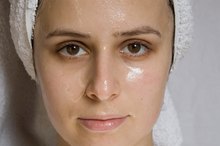How to Reverse Collagen Loss as You Get Older
Collagen is a protein made of amino acids that is part of the connective tissue in skin. It helps to maintain your skin's firmness, suppleness and consistent renewal of skin cells. With age, collagen production decreases and skin becomes prone to damage, wrinkles and sagging. To increase your skin's production of collagen, adopt a healthy lifestyle and diet, and seek out topical treatments proven to be effective in maintaining the youthful appearance of your skin.
Change Your Diet
Make a few changes to your diet to increase cell turnover and boost the production of collagen fibers. Avoid refined sugar and carbs, as sugar damages collagen production. Instead, satisfy your sweet tooth with whole foods such as berries, carrots and oranges. Be careful not to cut out healthy fats and carbs from you diet -- such as nuts, avocados and brown rice -- to avoid being deficient in vitamins and nutrients that aid in the production of collagen.
- Make a few changes to your diet to increase cell turnover and boost the production of collagen fibers.
- Be careful not to cut out healthy fats and carbs from you diet -- such as nuts, avocados and brown rice -- to avoid being deficient in vitamins and nutrients that aid in the production of collagen.
Exercise
How to Stop Acne Scarring
Learn More
Adopt an exercise regimen. Lift light weights or do resistance training to build muscle. Muscle development can stimulate collagen growth, while muscle loss can contribute to sagging skin. Further boost your body's collagen production by going on a 10-minute jog in the midday sun to get your daily dose of vitamin D. While vitamin D hasn't been proven to increase the body's production of collagen, studies have shown that a vitamin D deficiency can reduce collagen synthesis.
- Adopt an exercise regimen.
- Further boost your body's collagen production by going on a 10-minute jog in the midday sun to get your daily dose of vitamin D. While vitamin D hasn't been proven to increase the body's production of collagen, studies have shown that a vitamin D deficiency can reduce collagen synthesis.
Vitamin A Treatments
Use a topical application of vitamin A to increase your skin's collagen production. Look for retinol -- a derivative of vitamin A -- in the ingredient list of creams, serums and spot treatments. Studies have shown retinol to effectively stimulate collagen synthesis in naturally aged skin. Keep in mind that retinol acts as a gentle exfoliant, so your skin will be more prone to sun damage. Protect your skin by wearing a broad-spectrum sunblock or sunscreen.
- Use a topical application of vitamin A to increase your skin's collagen production.
Avoid Collagen Killers
How to Get Rid of Dark Circles Around the Mouth
Learn More
Adopt a healthy lifestyle to aid your body in producing collagen. Minimize time in the sun, and ensure that you properly protect your skin when out in the sun by wearing sunscreen or sunblock. Do not smoke and avoid environments where you might be prone to secondhand smoke. Minimize emotional stress or engage in relaxing activities such as yoga. Ensure that you get a good night's sleep, as this is the time when the body -- including your skin -- repairs itself.
- Adopt a healthy lifestyle to aid your body in producing collagen.
- Minimize time in the sun, and ensure that you properly protect your skin when out in the sun by wearing sunscreen or sunblock.
Related Articles
References
- Fox News: 8 Diet and Exercise Mistakes that Age You
- NCBI: Vitamin A antagonizes decreased cell growth and elevated collagen-degrading matrix metalloproteinases and stimulates collagen accumulation in naturally aged human skin.
- NCBI: Effects of vitamin D metabolites on collagen production and cell proliferation of growth zone and resting zone cartilage cells in vitro.
- Total Beauty.com: Why You Need a Daytime Retinol Now
- Medical.net: Collagen - What is Collagen?
- Asserin, J., Lati, E., Shioya, T., & Prawitt, J. (2015). The effect of oral collagen peptide supplementation on skin moisture and the dermal collagen network: evidence from anex vivomodel and randomized, placebo-controlled clinical trials. Journal of Cosmetic Dermatology, 14(4), 291–301. doi:10.1111/jocd.12174
- Choi FD, Sung CT, Juhasz ML, Mesinkovsk NA. Oral Collagen Supplementation: A Systematic Review of Dermatological Applications. J Drugs Dermatol. 2019;18(1):9-16.
- Cúneo F, Costa-Paiva L, Pinto-Neto AM, Morais SS, Amaya-Farfan J. Effect of dietary supplementation with collagen hydrolysates on bone metabolism of postmenopausal women with low mineral density. Maturitas. 2010 Mar;65(3):253-7.
- Czajka, A., Kania, E. M., Genovese, L., Corbo, A., Merone, G., Luci, C., & Sibilla, S. (2018). Daily oral supplementation with collagen peptides combined with vitamins and other bioactive compounds improves skin elasticity and has a beneficial effect on joint and general wellbeing. Nutrition Research, 57, 97–108. doi:10.1016/j.nutres.2018.06.001
- García-Coronado, J. M., Martínez-Olvera, L., Elizondo-Omaña, R. E., Acosta-Olivo, C. A., Vilchez-Cavazos, F., Simental-Mendía, L. E., & Simental-Mendía, M. (2018). Effect of collagen supplementation on osteoarthritis symptoms: a meta-analysis of randomized placebo-controlled trials. International Orthopaedics, 43(3), 531–538. doi:10.1007/s00264-018-4211-5
- Hays NP, Kim H, Wells AM, Kajkenova O, Evans WJ. "Effects of whey and fortified collagen hydrolysate protein supplements on nitrogen balance and body composition in older women." J Am Diet Assoc. 2009 Jun;109(6):1082-7.
- Kirmse, M., Oertzen-Hagemann, V., de Marées, M., Bloch, W., & Platen, P. (2019). Prolonged Collagen Peptide Supplementation and Resistance Exercise Training Affects Body Composition in Recreationally Active Men. Nutrients, 11(5), 1154. doi:10.3390/nu11051154
- Proksch E, Schunck M, Zague V, Segger D, Degwert J, Oesser S. Oral intake of specific bioactive collagen peptides reduces skin wrinkles and increases dermal matrix synthesis. Skin Pharmacol Physiol. 2014;27(3):113-9.
- Proksch E, Segger D, Degwert J, Schunck M, Zague V, Oesser S. Oral supplementation of specific collagen peptides has beneficial effects on human skin physiology: a double-blind, placebo-controlled study. Skin Pharmacol Physiol. 2014;27(1):47-55.
- Tomosugi N, Yamamoto S, Takeuchi M, et al. Effect of Collagen Tripeptide on Atherosclerosis in Healthy Humans. J Atheroscler Thromb. 2017;24(5):530–538. doi:10.5551/jat.36293
Resources
Writer Bio
What does a fashion aficionado hailing from New York do when she turns of age? Travel the world and write about fashion. From New York to Bangkok, from Onyxmilk (USA) to Adorned Magazine (UK), Lindsay Christinee has traveled and written about it all since 2009.









